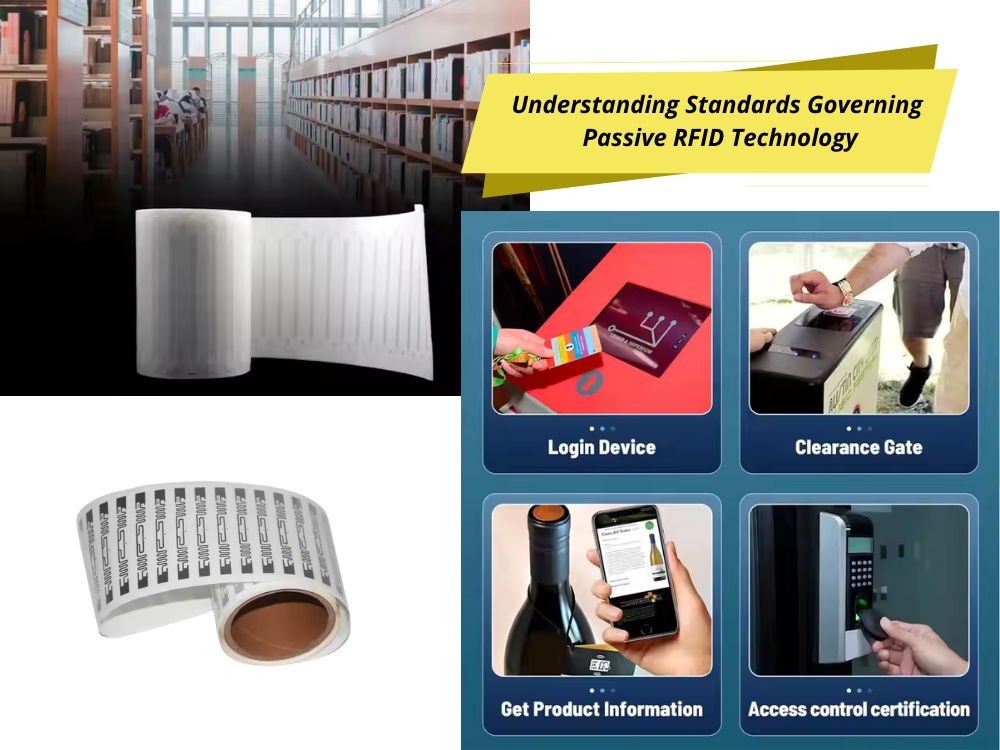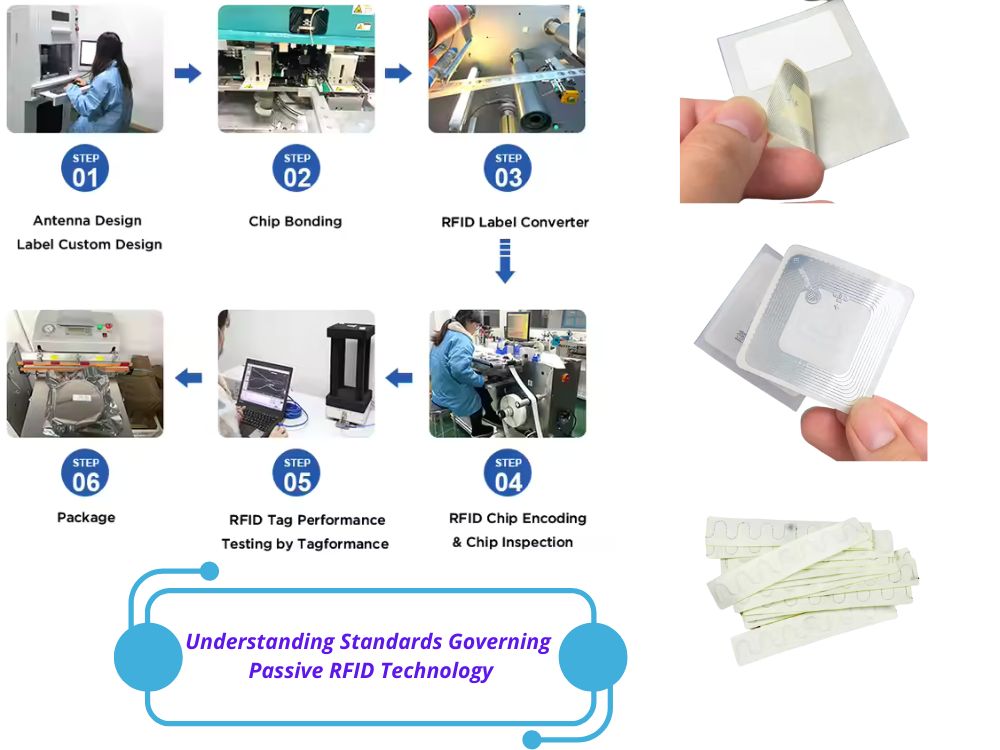
Understanding Standards Governing Passive RFID Technology
Table of Contents
Summary
These standards, established by the International Organization for Standardization (ISO) and other regulatory bodies, are crucial for the effective use of RFID systems in various industries. This article provides a comprehensive overview of the key standards that govern passive RFID technology.

ISO Standards for Passive RFID
ISO 15693: High-Frequency Vicinity Cards
ISO 15693 defines the air-interface protocol for high-frequency (HF) RFID tags, designed for vicinity card applications. This standard supports a read range of up to 3 feet (0.9 meters) and is commonly used for access control and inventory management, such as tracking medical samples and small items.
ISO 14443: High-Frequency Proximity Cards
ISO 14443 specifies the air-interface protocol for HF RFID tags used in proximity cards. This standard ensures a short read range, typically just a few inches, making it suitable for secure applications like financial transactions and personal identification.
ISO 18000 Series: Air-Interface Protocols for RFID
The ISO 18000 series covers a broad spectrum of air-interface protocols for various RFID systems. This series addresses different frequencies and application needs, facilitating global standardization and compatibility.
Standard | Frequency | Description |
ISO 18000-1 | Global | Generic parameters for air interfaces across globally accepted frequencies. |
ISO 18000-2 | 135 kHz | Air-interface protocol for low-frequency systems. |
ISO 18000-3 | 13.56 MHz | Air-interface protocol for HF systems, including EPC HF standards. |
ISO 18000-4 | 2.45 GHz | Air-interface protocol for active RFID systems at 2.45 GHz. |
ISO 18000-5 | 5.8 GHz | Air-interface protocol for active RFID systems at 5.8 GHz. |
ISO 18000-6 | 860-930 MHz | Air-interface protocol for passive RFID systems in the UHF range. |
ISO 18000-7 | 433 MHz | Air-interface protocol for active RFID systems at 433 MHz. |
Key Protocols for Passive RFID
ISO 18000-6C: UHF RFID (EPC Gen 2)
The ISO 18000-6C standard, also known as EPC Gen 2, is the major air-interface protocol for ultrahigh-frequency (UHF) RFID. Developed by GS1 EPCglobal, this protocol enhances global compatibility and is widely adopted in supply chain management and asset tracking.
ISO 18000-3: HF EPC
The HF EPC standard, based on ISO 18000-3, is used for high-frequency RFID applications and aligns with the EPC global standards for interoperability in HF RFID systems.

Conclusion
The standards governing passive RFID technology are essential for ensuring compatibility and effectiveness across various applications and frequencies. By adhering to these protocols, organizations can enhance the reliability of their RFID systems and facilitate seamless integration in their operational processes. As RFID technology continues to evolve, staying informed about these standards will be crucial for leveraging its full potential in asset management, access control, and beyond.
Comments
Hot Products

What Is RFID Waste Management
Imagine a city where every trash bin speaks — not literally — but through a tiny chip that tells the system when it’s full, when it’s emptied, and where it went. That’s what RFID waste management is doing today.

What are Bolt Seals and their Applications? | Complete Guide
In global trade and logistics, bolt seals play a crucial role in ensuring cargo security and compliance. These small but powerful devices are designed to lock shipping containers, trailers, and cargo doors with a tamper-evident mechanism.

What is an RFID Card Protector? Benefits, Use Cases, and Buying Guide
RFID technology (Radio Frequency Identification) is everywhere: in your credit cards, ID badges, transit passes, hotel room keys, and more. It offers speed and convenience, but it also opens the door to a new kind of digital theft called “skimming.” That’s where an RFID card protector comes in.

RFID Wristbands for Events: Bulk Buying Guide for Organizers
RFID wristbands for events are becoming the go-to solution for organizers who need faster entry, fraud prevention, and cashless payments at concerts, festivals, and sports venues. Unlike paper tickets or QR codes, these smart wristbands use embedded chips to streamline access, secure transactions, and improve the guest experience.

How RFID Tag on Windscreen Improves Vehicle Access Control and Toll Systems
In today’s fast-paced world, vehicle identification needs to be quick, secure, and contactless. An RFID Tag on the Windscreen provides exactly that — a reliable way to manage toll collection, parking, and gated access without stopping vehicles.

The Benefits of RFID Linen Tags in Commercial Laundry
Managing laundry in hospitals, hotels, or large laundry services is a big job. Each day, thousands of sheets, towels, and uniforms are washed, sorted, and sent back out. But problems like lost linens, sorting mistakes, and manual counting can cost companies a lot of money. For example, mid-sized hotels can lose over $200,000 each year from missing linens.
That’s where RFID Linen Tags come in.
Tags
RELATED BLOGS

What Is RFID Waste Management
Imagine a city where every trash bin speaks — not literally — but through a tiny chip that tells the system when it’s full, when it’s emptied, and where it went. That’s what RFID waste management is doing today.

What are Bolt Seals and their Applications? | Complete Guide
In global trade and logistics, bolt seals play a crucial role in ensuring cargo security and compliance. These small but powerful devices are designed to lock shipping containers, trailers, and cargo doors with a tamper-evident mechanism.

What is an RFID Card Protector? Benefits, Use Cases, and Buying Guide
RFID technology (Radio Frequency Identification) is everywhere: in your credit cards, ID badges, transit passes, hotel room keys, and more. It offers speed and convenience, but it also opens the door to a new kind of digital theft called “skimming.” That’s where an RFID card protector comes in.




